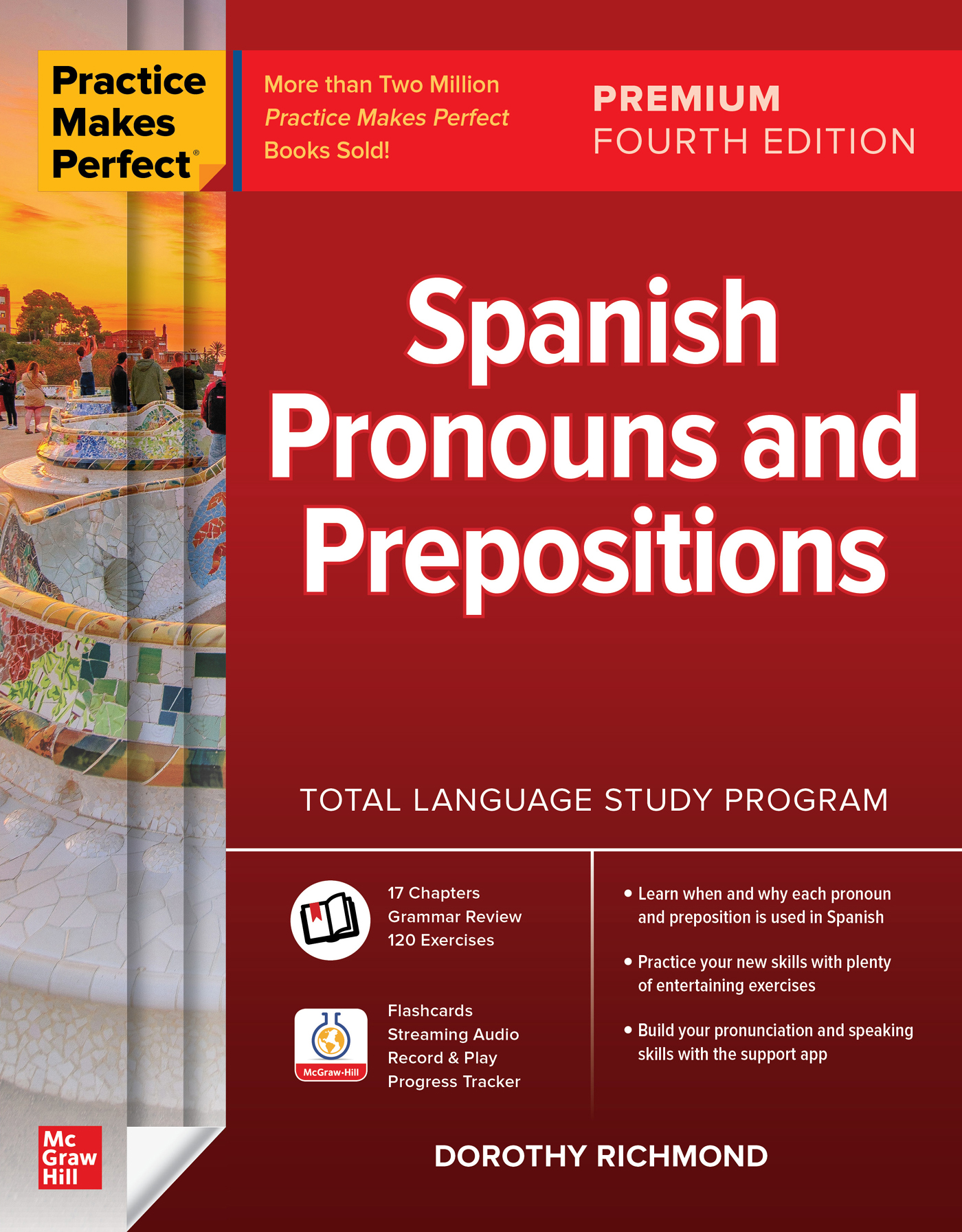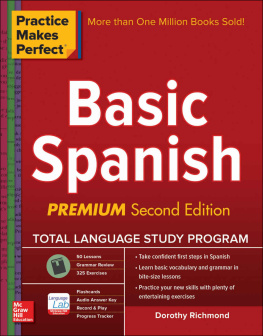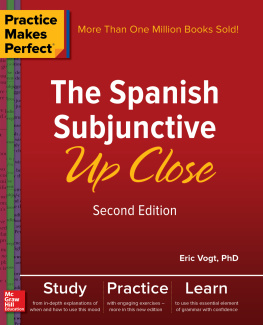Dorothy Richmond - Spanish: Practice Makes Perfect
Here you can read online Dorothy Richmond - Spanish: Practice Makes Perfect full text of the book (entire story) in english for free. Download pdf and epub, get meaning, cover and reviews about this ebook. year: 2021, publisher: McGraw-Hill Education, genre: Home and family. Description of the work, (preface) as well as reviews are available. Best literature library LitArk.com created for fans of good reading and offers a wide selection of genres:
Romance novel
Science fiction
Adventure
Detective
Science
History
Home and family
Prose
Art
Politics
Computer
Non-fiction
Religion
Business
Children
Humor
Choose a favorite category and find really read worthwhile books. Enjoy immersion in the world of imagination, feel the emotions of the characters or learn something new for yourself, make an fascinating discovery.

- Book:Spanish: Practice Makes Perfect
- Author:
- Publisher:McGraw-Hill Education
- Genre:
- Year:2021
- Rating:4 / 5
- Favourites:Add to favourites
- Your mark:
- 80
- 1
- 2
- 3
- 4
- 5
Spanish: Practice Makes Perfect: summary, description and annotation
We offer to read an annotation, description, summary or preface (depends on what the author of the book "Spanish: Practice Makes Perfect" wrote himself). If you haven't found the necessary information about the book — write in the comments, we will try to find it.
Spanish: Practice Makes Perfect — read online for free the complete book (whole text) full work
Below is the text of the book, divided by pages. System saving the place of the last page read, allows you to conveniently read the book "Spanish: Practice Makes Perfect" online for free, without having to search again every time where you left off. Put a bookmark, and you can go to the page where you finished reading at any time.
Font size:
Interval:
Bookmark:




Copyright 2021 by McGraw Hill. All rights reserved. Except as permitted under the United States Copyright Act of 1976, no part of this publication may be reproduced or distributed in any form or by any means, or stored in a database or retrieval system, without the prior written permission of the publisher.
ISBN: 978-1-26-046755-0
MHID: 1-26-046755-4
The material in this eBook also appears in the print version of this title: ISBN: 978-1-26-046754-3, MHID: 1-26-046754-6.
eBook conversion by codeMantra
Version 1.0
All trademarks are trademarks of their respective owners. Rather than put a trademark symbol after every occurrence of a trademarked name, we use names in an editorial fashion only, and to the benefit of the trademark owner, with no intention of infringement of the trademark. Where such designations appear in this book, they have been printed with initial caps.
McGraw-Hill Education eBooks are available at special quantity discounts to use as premiums and sales promotions or for use in corporate training programs. To contact a representative, please visit the Contact Us page at www.mhprofessional.com.
McGraw Hill Language Lab App
Audio recordings and flashcards are available to support your study of this book. Go to mhlanguagelab.com to access the online version of this application, or to locate links to the mobile app for iOS and Android devices. More details about the features of the app are available on the inside front and back covers.
TERMS OF USE
This is a copyrighted work and McGraw-Hill Education and its licensors reserve all rights in and to the work. Use of this work is subject to these terms. Except as permitted under the Copyright Act of 1976 and the right to store and retrieve one copy of the work, you may not decompile, disassemble, reverse engineer, reproduce, modify, create derivative works based upon, transmit, distribute, disseminate, sell, publish or sublicense the work or any part of it without McGraw-Hill Educations prior consent. You may use the work for your own noncommercial and personal use; any other use of the work is strictly prohibited. Your right to use the work may be terminated if you fail to comply with these terms.
THE WORK IS PROVIDED AS IS. McGRAW-HILL EDUCATION AND ITS LICENSORS MAKE NO GUARANTEES OR WARRANTIES AS TO THE ACCURACY, ADEQUACY OR COMPLETENESS OF OR RESULTS TO BE OBTAINED FROM USING THE WORK, INCLUDING ANY INFORMATION THAT CAN BE ACCESSED THROUGH THE WORK VIA HYPERLINK OR OTHERWISE, AND EXPRESSLY DISCLAIM ANY WARRANTY, EXPRESS OR IMPLIED, INCLUDING BUT NOT LIMITED TO IMPLIED WARRANTIES OF MERCHANTABILITY OR FITNESS FOR A PARTICULAR PURPOSE. McGraw-Hill Education and its licensors do not warrant or guarantee that the functions contained in the work will meet your requirements or that its operation will be uninterrupted or error free. Neither McGraw-Hill Education nor its licensors shall be liable to you or anyone else for any inaccuracy, error or omission, regardless of cause, in the work or for any damages resulting therefrom. McGraw-Hill Education has no responsibility for the content of any information accessed through the work. Under no circumstances shall McGraw-Hill Education and/or its licensors be liable for any indirect, incidental, special, punitive, consequential or similar damages that result from the use of or inability to use the work, even if any of them has been advised of the possibility of such damages. This limitation of liability shall apply to any claim or cause whatsoever whether such claim or cause arises in contract, tort or otherwise.
To Daisy Richmond and Lily Richmond, the greatest loves of my life
Pronouns and prepositions are two aspects of language study that often fall through the cracks. It is not unusual to encounter individuals who have studied Spanish for years and whose vocabulary and ability to conjugate verbs are impressive, yet who trip over pronouns, unable to distinguish between direct and indirect object pronouns, and who dont really get para and por.
To say that Spanish pronouns and prepositions are undertaught and underlearned is an understatement. Mastery of them is essential for all students who desire to communicate with native speakers of Spanish or who simply wish to absorb the wealth of literaturefrom the classics to the latest fan magazinesin Spanish. Though vastly different on the surface, mastery of both requires meticulous attention to detail, careful study of both vocabulary and theory, and almost endless repetitive practice and use, until that magic moment when one simply uses pronouns and prepositions without thought, without effort, without regret for the time and energy spent learning them.
Current books on the market invariably fall short of providing sufficient discussion, examples, and exercises that allow the student to properly learn how to work with Spanish pronouns and prepositions. Practice Makes Perfect: Spanish Pronouns and Prepositions meets the need for explaining and practicing these two vital parts of speech.
The challenge of this text, for both the author and the student, is to take on these two very important, yet often ignored, aspects of the Spanish language. For every student who takes this challenge, I offer you congratulations and wish you great academic fortune.
It is a great honor to have a textbook go into subsequent editions because it means that the book has done its intended job well. Thus, my first thanks go to the many students who made such extensive and productive use of the previous editions of Pronouns and Prepositions that another edition was warranted.
As ever, I am happy to be working with Christopher Brown, my longtime editor, publisher, and friend at McGraw-Hill who oversaw the production of this book and with whom Ive worked on several titles. I am ever grateful for Christophers intelligence, attention to detail, and kindness.
My daughters, Daisy and Lily Richmond, continue to inspire and challenge me in all ways significant.
In order to work with any systema software program, a car, an organization, or a languageone must know its constituent parts, how to use them, and what each part means and contributes to the whole. This book deals primarily with Spanish pronouns and prepositions, which are crucial to the Spanish language system.
A pronoun replaces an understood noun. Therefore, in order to use a pronoun, the speaker/writer and listener/reader must already be in agreement on what or whom the noun refers to. If you breeze into a room and announce, I saw him last night, you will be greeted by blank stares and the question Whom did you see? On the other hand, if you made this same announcement after you and your friends had been talking about the ghost of Elvis, you still might get some stares, but everyone would understand whom you meant. And being understoodputting what is going on in your mind into someone elses mindis the essence and aim of all communication.
Font size:
Interval:
Bookmark:
Similar books «Spanish: Practice Makes Perfect»
Look at similar books to Spanish: Practice Makes Perfect. We have selected literature similar in name and meaning in the hope of providing readers with more options to find new, interesting, not yet read works.
Discussion, reviews of the book Spanish: Practice Makes Perfect and just readers' own opinions. Leave your comments, write what you think about the work, its meaning or the main characters. Specify what exactly you liked and what you didn't like, and why you think so.


